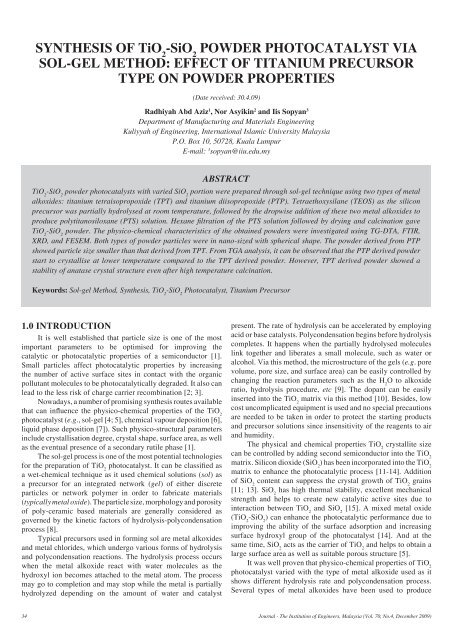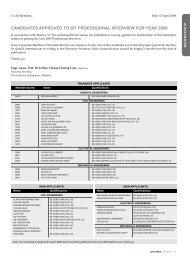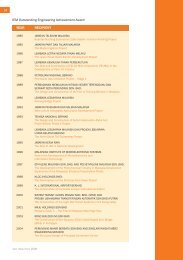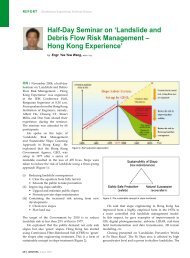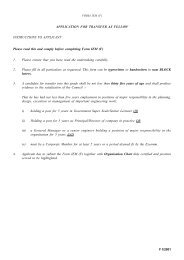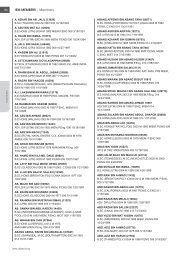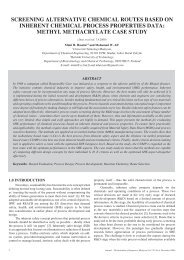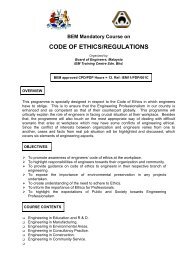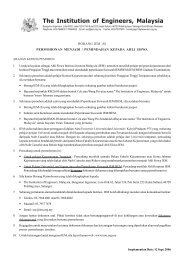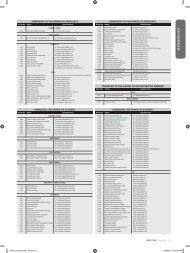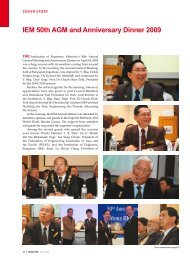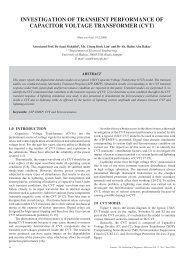effect of titanium precursor type on powder properties - IEM
effect of titanium precursor type on powder properties - IEM
effect of titanium precursor type on powder properties - IEM
Create successful ePaper yourself
Turn your PDF publications into a flip-book with our unique Google optimized e-Paper software.
SYNTHESIS OF TiO 2<br />
-SiO 2<br />
POWDER PHOTOCATALYST VIA<br />
SOL-GEL METHOD: EFFECT OF TITANIUM PRECURSOR<br />
TYPE ON POWDER PROPERTIES<br />
(Date received: 30.4.09)<br />
Radhiyah Abd Aziz 1 , Nor Asyikin 2 and Iis Sopyan 3<br />
Department <str<strong>on</strong>g>of</str<strong>on</strong>g> Manufacturing and Materials Engineering<br />
Kuliyyah <str<strong>on</strong>g>of</str<strong>on</strong>g> Engineering, Internati<strong>on</strong>al Islamic University Malaysia<br />
P.O. Box 10, 50728, Kuala Lumpur<br />
E-mail: 3 sopyan@iiu.edu.my<br />
abstract<br />
TiO 2<br />
-SiO 2<br />
<strong>powder</strong> photocatalysts with varied SiO 2<br />
porti<strong>on</strong> were prepared through sol-gel technique using two <str<strong>on</strong>g>type</str<strong>on</strong>g>s <str<strong>on</strong>g>of</str<strong>on</strong>g> metal<br />
alkoxides: <str<strong>on</strong>g>titanium</str<strong>on</strong>g> tetraisopropoxide (TPT) and <str<strong>on</strong>g>titanium</str<strong>on</strong>g> diisopropoxide (PTP). Tetraethoxysilane (TEOS) as the silic<strong>on</strong><br />
<str<strong>on</strong>g>precursor</str<strong>on</strong>g> was partially hydrolysed at room temperature, followed by the dropwise additi<strong>on</strong> <str<strong>on</strong>g>of</str<strong>on</strong>g> these two metal alkoxides to<br />
produce polytitanosiloxane (PTS) soluti<strong>on</strong>. Hexane filtrati<strong>on</strong> <str<strong>on</strong>g>of</str<strong>on</strong>g> the PTS soluti<strong>on</strong> followed by drying and calcinati<strong>on</strong> gave<br />
TiO 2<br />
-SiO 2<br />
<strong>powder</strong>. The physico-chemical characteristics <str<strong>on</strong>g>of</str<strong>on</strong>g> the obtained <strong>powder</strong>s were investigated using TG-DTA, FTIR,<br />
XRD, and FESEM. Both <str<strong>on</strong>g>type</str<strong>on</strong>g>s <str<strong>on</strong>g>of</str<strong>on</strong>g> <strong>powder</strong> particles were in nano-sized with spherical shape. The <strong>powder</strong> derived from PTP<br />
showed particle size smaller than that derived from TPT. From TGA analysis, it can be observed that the PTP derived <strong>powder</strong><br />
start to crystallise at lower temperature compared to the TPT derived <strong>powder</strong>. However, TPT derived <strong>powder</strong> showed a<br />
stability <str<strong>on</strong>g>of</str<strong>on</strong>g> anatase crystal structure even after high temperature calcinati<strong>on</strong>.<br />
Keywords: Sol-gel Method, Synthesis, TiO 2<br />
-SiO 2<br />
Photocatalyst, Titanium Precursor<br />
1.0 INTRODUCTION<br />
It is well established that particle size is <strong>on</strong>e <str<strong>on</strong>g>of</str<strong>on</strong>g> the most<br />
important parameters to be optimised for improving the<br />
catalytic or photocatalytic <strong>properties</strong> <str<strong>on</strong>g>of</str<strong>on</strong>g> a semic<strong>on</strong>ductor [1].<br />
Small particles affect photocatalytic <strong>properties</strong> by increasing<br />
the number <str<strong>on</strong>g>of</str<strong>on</strong>g> active surface sites in c<strong>on</strong>tact with the organic<br />
pollutant molecules to be photocatalytically degraded. It also can<br />
lead to the less risk <str<strong>on</strong>g>of</str<strong>on</strong>g> charge carrier recombinati<strong>on</strong> [2; 3].<br />
Nowadays, a number <str<strong>on</strong>g>of</str<strong>on</strong>g> promising synthesis routes available<br />
that can influence the physico-chemical <strong>properties</strong> <str<strong>on</strong>g>of</str<strong>on</strong>g> the TiO 2<br />
photocatalyst (e.g., sol-gel [4; 5], chemical vapour depositi<strong>on</strong> [6],<br />
liquid phase depositi<strong>on</strong> [7]). Such physico-structural parameters<br />
include crystallisati<strong>on</strong> degree, crystal shape, surface area, as well<br />
as the eventual presence <str<strong>on</strong>g>of</str<strong>on</strong>g> a sec<strong>on</strong>dary rutile phase [1].<br />
The sol-gel process is <strong>on</strong>e <str<strong>on</strong>g>of</str<strong>on</strong>g> the most potential technologies<br />
for the preparati<strong>on</strong> <str<strong>on</strong>g>of</str<strong>on</strong>g> TiO 2<br />
photocatalyst. It can be classified as<br />
a wet-chemical technique as it used chemical soluti<strong>on</strong>s (sol) as<br />
a <str<strong>on</strong>g>precursor</str<strong>on</strong>g> for an integrated network (gel) <str<strong>on</strong>g>of</str<strong>on</strong>g> either discrete<br />
particles or network polymer in order to fabricate materials<br />
(typically metal oxide). The particle size, morphology and porosity<br />
<str<strong>on</strong>g>of</str<strong>on</strong>g> poly-ceramic based materials are generally c<strong>on</strong>sidered as<br />
governed by the kinetic factors <str<strong>on</strong>g>of</str<strong>on</strong>g> hydrolysis-polyc<strong>on</strong>densati<strong>on</strong><br />
process [8].<br />
Typical <str<strong>on</strong>g>precursor</str<strong>on</strong>g>s used in forming sol are metal alkoxides<br />
and metal chlorides, which undergo various forms <str<strong>on</strong>g>of</str<strong>on</strong>g> hydrolysis<br />
and polyc<strong>on</strong>densati<strong>on</strong> reacti<strong>on</strong>s. The hydrolysis process occurs<br />
when the metal alkoxide react with water molecules as the<br />
hydroxyl i<strong>on</strong> becomes attached to the metal atom. The process<br />
may go to completi<strong>on</strong> and may stop while the metal is partially<br />
hydrolyzed depending <strong>on</strong> the amount <str<strong>on</strong>g>of</str<strong>on</strong>g> water and catalyst<br />
present. The rate <str<strong>on</strong>g>of</str<strong>on</strong>g> hydrolysis can be accelerated by employing<br />
acid or base catalysts. Polyc<strong>on</strong>densati<strong>on</strong> begins before hydrolysis<br />
completes. It happens when the partially hydrolysed molecules<br />
link together and liberates a small molecule, such as water or<br />
alcohol. Via this method, the microstructure <str<strong>on</strong>g>of</str<strong>on</strong>g> the gels (e.g. pore<br />
volume, pore size, and surface area) can be easily c<strong>on</strong>trolled by<br />
changing the reacti<strong>on</strong> parameters such as the H 2<br />
O to alkoxide<br />
ratio, hydrolysis procedure, etc [9]. The dopant can be easily<br />
inserted into the TiO 2<br />
matrix via this method [10]. Besides, low<br />
cost uncomplicated equipment is used and no special precauti<strong>on</strong>s<br />
are needed to be taken in order to protect the starting products<br />
and <str<strong>on</strong>g>precursor</str<strong>on</strong>g> soluti<strong>on</strong>s since insensitivity <str<strong>on</strong>g>of</str<strong>on</strong>g> the reagents to air<br />
and humidity.<br />
The physical and chemical <strong>properties</strong> TiO 2<br />
crystallite size<br />
can be c<strong>on</strong>trolled by adding sec<strong>on</strong>d semic<strong>on</strong>ductor into the TiO 2<br />
matrix. Silic<strong>on</strong> dioxide (SiO 2<br />
) has been incorporated into the TiO 2<br />
matrix to enhance the photocatalytic process [11-14]. Additi<strong>on</strong><br />
<str<strong>on</strong>g>of</str<strong>on</strong>g> SiO 2<br />
c<strong>on</strong>tent can suppress the crystal growth <str<strong>on</strong>g>of</str<strong>on</strong>g> TiO 2<br />
grains<br />
[11; 13]. SiO 2<br />
has high thermal stability, excellent mechanical<br />
strength and helps to create new catalytic active sites due to<br />
interacti<strong>on</strong> between TiO 2<br />
and SiO 2<br />
[15]. A mixed metal oxide<br />
(TiO 2<br />
-SiO 2<br />
) can enhance the photocatalytic performance due to<br />
improving the ability <str<strong>on</strong>g>of</str<strong>on</strong>g> the surface adsorpti<strong>on</strong> and increasing<br />
surface hydroxyl group <str<strong>on</strong>g>of</str<strong>on</strong>g> the photocatalyst [14]. And at the<br />
same time, SiO 2<br />
acts as the carrier <str<strong>on</strong>g>of</str<strong>on</strong>g> TiO 2<br />
and helps to obtain a<br />
large surface area as well as suitable porous structure [5].<br />
It was well proven that physico-chemical <strong>properties</strong> <str<strong>on</strong>g>of</str<strong>on</strong>g> TiO 2<br />
photocatalyst varied with the <str<strong>on</strong>g>type</str<strong>on</strong>g> <str<strong>on</strong>g>of</str<strong>on</strong>g> metal alkoxide used as it<br />
shows different hydrolysis rate and polyc<strong>on</strong>densati<strong>on</strong> process.<br />
Several <str<strong>on</strong>g>type</str<strong>on</strong>g>s <str<strong>on</strong>g>of</str<strong>on</strong>g> metal alkoxides have been used to produce<br />
34<br />
Journal - The Instituti<strong>on</strong> <str<strong>on</strong>g>of</str<strong>on</strong>g> Engineers, Malaysia (Vol. 70, No.4, December 2009)<br />
034-040•Synthesis <str<strong>on</strong>g>of</str<strong>on</strong>g> Ti02-Si02 4pp.indd 34<br />
1/21/2010 9:47:02 AM
SYNTHESIS OF TiO 2<br />
-SiO 2<br />
POWDER PHOTOCATALYST VIA SOL-GEL METHOD: EFFECT OF TITANIUM PRECURSOR TYPE ON POWDER PROPERTIES<br />
TiO 2<br />
photocatalyst; <str<strong>on</strong>g>titanium</str<strong>on</strong>g> diisopropoxide [16; 17], <str<strong>on</strong>g>titanium</str<strong>on</strong>g><br />
tetraisopropoxide [18-20], <str<strong>on</strong>g>titanium</str<strong>on</strong>g> tetra-n-butoxide [21-23],<br />
amm<strong>on</strong>ium hexafluorotitanate [24], <str<strong>on</strong>g>titanium</str<strong>on</strong>g> tetrachloride [25-<br />
27], titanyl sulphate [28-31], <str<strong>on</strong>g>titanium</str<strong>on</strong>g> oxyhydrate [14].<br />
Peroxo titanic acid derived from TiCl 4<br />
needs a lower<br />
temperature operati<strong>on</strong> such as 0-5°C in the ice-water bath<br />
which is difficult to fit in the industrial process [25]. Titanium<br />
tetraisopropoxide which are mostly used as a <str<strong>on</strong>g>precursor</str<strong>on</strong>g> material<br />
for sol-gel process is generally highly reactive species [32]. To<br />
c<strong>on</strong>trol the hydrolysis and polyc<strong>on</strong>densati<strong>on</strong> process in sol-gel<br />
route, it may be achieved through the additi<strong>on</strong> <str<strong>on</strong>g>of</str<strong>on</strong>g> “modifiers”,<br />
such as β-diket<strong>on</strong>es (e.g., acetylacet<strong>on</strong>ate), carboxylic acids<br />
(e.g., acetic acid) or other complex ligands [32]. Titanium<br />
diisopropoxide is categorised as modified metal alkoxide due<br />
to the presence <str<strong>on</strong>g>of</str<strong>on</strong>g> acetylacet<strong>on</strong>ate (acac) ligand; where the acac<br />
ligand is attached to the Ti element. It is known that the acac<br />
ligand structure can increase the stability <str<strong>on</strong>g>of</str<strong>on</strong>g> the metal alkoxide<br />
by functi<strong>on</strong>ing as a chelating agent [33]. Besides, the chemical<br />
modificati<strong>on</strong> <str<strong>on</strong>g>of</str<strong>on</strong>g> <str<strong>on</strong>g>titanium</str<strong>on</strong>g> alkoxide would lead to the producti<strong>on</strong><br />
<str<strong>on</strong>g>of</str<strong>on</strong>g> well-defined <strong>powder</strong>s at lower reacti<strong>on</strong> temperature. This<br />
chelating ligand is used to c<strong>on</strong>trol the c<strong>on</strong>densati<strong>on</strong> and the<br />
evoluti<strong>on</strong> <str<strong>on</strong>g>of</str<strong>on</strong>g> the polymer [34] and prevents the precipitati<strong>on</strong><br />
<str<strong>on</strong>g>of</str<strong>on</strong>g> undesired phase [32]. The acac group b<strong>on</strong>ded to <str<strong>on</strong>g>titanium</str<strong>on</strong>g><br />
prevents rapid hydrolysis by altering the c<strong>on</strong>densati<strong>on</strong> pathway<br />
[32; 35].<br />
In this present study, we have synthesised the TiO 2<br />
-SiO 2<br />
<strong>powder</strong> via sol gel method using two different metal alkoxide:<br />
<str<strong>on</strong>g>titanium</str<strong>on</strong>g> diisopropoxide (PTP) and <str<strong>on</strong>g>titanium</str<strong>on</strong>g> tetraisopropoxide<br />
(TPT). The physico-chemical property <str<strong>on</strong>g>of</str<strong>on</strong>g> the TiO 2<br />
-SiO 2<br />
<strong>powder</strong><br />
obtained has been also carried out to investigate the <str<strong>on</strong>g>effect</str<strong>on</strong>g><br />
<str<strong>on</strong>g>of</str<strong>on</strong>g> different metal alkoxide use in synthesing the TiO 2<br />
-SiO 2<br />
<strong>powder</strong>.<br />
added dropwise. The molar ratio <str<strong>on</strong>g>of</str<strong>on</strong>g> HCl/TEOS, H 2<br />
O/TEOS and<br />
PTP (or TPT)/TEOS were summarised in Table 1. The heating<br />
process was started and c<strong>on</strong>tinued until the reflux temperature<br />
reached about 74˚C. The heating was stopped after 10 minutes<br />
and PTS soluti<strong>on</strong> was finally obtained. This PTS soluti<strong>on</strong> was<br />
used to produce TiO 2<br />
-SiO 2<br />
<strong>powder</strong> via acet<strong>on</strong>e dissoluti<strong>on</strong> and<br />
hexane filtrati<strong>on</strong> process. The procedures were summarised in<br />
the flowchart (Figure 1).<br />
2.0 EXPERIMENTAL<br />
2.1 Materials<br />
For preparati<strong>on</strong> <str<strong>on</strong>g>of</str<strong>on</strong>g> PTS as <str<strong>on</strong>g>precursor</str<strong>on</strong>g> soluti<strong>on</strong>, <str<strong>on</strong>g>titanium</str<strong>on</strong>g> (diisopropoxide)<br />
bis(acetyl-acet<strong>on</strong>ate) (PTP, Strem Chemicals,<br />
75% in isopropanol), <str<strong>on</strong>g>titanium</str<strong>on</strong>g> (IV) isopropoxide (TPT, Sigma-<br />
Aldrich), tetraethoxysilane (TEOS, Alfa Aesar, 98%), methanol<br />
and hydrochloric acid (Systerm, 36%) were used as raw<br />
materials.<br />
2.2 Preparati<strong>on</strong> <str<strong>on</strong>g>of</str<strong>on</strong>g> TiO 2<br />
-SiO 2<br />
<str<strong>on</strong>g>precursor</str<strong>on</strong>g> soluti<strong>on</strong><br />
The PTS <str<strong>on</strong>g>precursor</str<strong>on</strong>g> soluti<strong>on</strong> was produced by mixing<br />
TEOS and 30ml <str<strong>on</strong>g>of</str<strong>on</strong>g> methanol into the round-bottomed flask with<br />
stirring c<strong>on</strong>diti<strong>on</strong>. Into this soluti<strong>on</strong>, a mixture <str<strong>on</strong>g>of</str<strong>on</strong>g> 6N <str<strong>on</strong>g>of</str<strong>on</strong>g> HCl,<br />
distilled water and 30ml <str<strong>on</strong>g>of</str<strong>on</strong>g> methanol was added dropwise with<br />
10minutes stirring process to partially hydrolyse TEOS. Then,<br />
into the partially hydrolysed <str<strong>on</strong>g>of</str<strong>on</strong>g> TEOS soluti<strong>on</strong>, PTP or TPT was<br />
Figure 1: Scheme <str<strong>on</strong>g>of</str<strong>on</strong>g> TiO 2<br />
-SiO 2<br />
preparati<strong>on</strong> via sol-gel method<br />
Table 1: Weight compositi<strong>on</strong> <str<strong>on</strong>g>of</str<strong>on</strong>g> the raw materials used<br />
Sample TiO 2<br />
SiO 2<br />
PTP or TPT<br />
(mol)<br />
TEOS<br />
(mol)<br />
H 2<br />
O/TEOS<br />
mol ratio<br />
HCl/TEOS<br />
mol ratio<br />
Methanol<br />
(ml)<br />
P95/5 95 5 0.095 0.005 2 0.1 30<br />
P90/10 90 10 0.09 0.01 2 0.1 30<br />
P80/20 80 20 0.08 0.02 2 0.1 30<br />
P70/30 70 30 0.07 0.03 2 0.1 30<br />
Journal - The Instituti<strong>on</strong> <str<strong>on</strong>g>of</str<strong>on</strong>g> Engineers, Malaysia (Vol. 70, No.4, December 2009) 35<br />
034-040•Synthesis <str<strong>on</strong>g>of</str<strong>on</strong>g> Ti02-Si02 4pp.indd 35<br />
1/21/2010 9:47:03 AM
Radhiyah Abd Aziz, et al.<br />
2.3 Characterisati<strong>on</strong><br />
Crystal structure <str<strong>on</strong>g>of</str<strong>on</strong>g> sol-gel TiO 2<br />
-SiO 2<br />
<strong>powder</strong> was<br />
characterized using Shimadzu Diffractometer, XRD 6000 model<br />
with copper Kα radiati<strong>on</strong>. All samples were scanned between<br />
20° and 50° with 2.00°/min scan rate. Physical <strong>properties</strong><br />
such as size and shape <str<strong>on</strong>g>of</str<strong>on</strong>g> particle and surface morphology<br />
were characterised by using Field Emissi<strong>on</strong> Scanning Electr<strong>on</strong><br />
Micsroscope (FESEM) (JSM 6700F, JEOL). Differential and<br />
thermogravimetric analysis was carried out <strong>on</strong> the amorphous<br />
TiO 2<br />
-SiO 2<br />
<strong>powder</strong> in ambient air using Thermogravimetric and<br />
Differential Thermal Analyser (TG/DTA) (Pyris Diam<strong>on</strong>d,<br />
Perkin Elmer) with a 2°C/min heating rate to determine the<br />
thermal <strong>properties</strong> <str<strong>on</strong>g>of</str<strong>on</strong>g> the sample. To examine the chemical b<strong>on</strong>d<br />
that appeared in the sample, the IR spectra were recorded using<br />
Fourier Transmissi<strong>on</strong> Infra-Red (FT-IR) (Spectrum 100, Perkin<br />
Elmer).<br />
(a)<br />
(b)<br />
the decompositi<strong>on</strong> <str<strong>on</strong>g>of</str<strong>on</strong>g> residual organic compounds c<strong>on</strong>tained in<br />
the metal alkoxide (acetylacet<strong>on</strong>ate group) and organic solvent<br />
used (methanol). A further weight loss after 350°C is probably<br />
due to the densificati<strong>on</strong> process <str<strong>on</strong>g>of</str<strong>on</strong>g> amorphous TiO 2<br />
<strong>powder</strong> until<br />
it crystallises to anatase crystal phase.<br />
From the Figures 2(a) and 2(b), it can be observed that<br />
different weight loss occurred for different SiO 2<br />
level. SiO 2<br />
has<br />
high thermal stability and excellent mechanical strength [15].<br />
Besides, it can help to create new catalytic active sites due to<br />
interacti<strong>on</strong> between TiO 2<br />
and SiO 2<br />
[15]. It showed that high<br />
compositi<strong>on</strong> <str<strong>on</strong>g>of</str<strong>on</strong>g> SiO 2<br />
leads to the less weight loss <str<strong>on</strong>g>of</str<strong>on</strong>g> sample<br />
during heating process. This observati<strong>on</strong> may be attributed<br />
to the thermal stability <str<strong>on</strong>g>of</str<strong>on</strong>g> sample with high SiO 2<br />
compositi<strong>on</strong><br />
(e.g., P70/30) compared to that <str<strong>on</strong>g>of</str<strong>on</strong>g> sample with low SiO 2<br />
compositi<strong>on</strong> (e.g., P95/5). The Si-O-Si b<strong>on</strong>d is very bendable<br />
and flexible. When adding bulky group into the structure, the<br />
rigidness <str<strong>on</strong>g>of</str<strong>on</strong>g> the structure will increase. The bulky group also<br />
hindered the flexibility and raised the transiti<strong>on</strong> temperature.<br />
Since the porti<strong>on</strong> <str<strong>on</strong>g>of</str<strong>on</strong>g> Ti in P70/30 is high comparable with the<br />
Si porti<strong>on</strong> for polyc<strong>on</strong>densati<strong>on</strong> reacti<strong>on</strong>, so that, more Si-O-Ti<br />
b<strong>on</strong>ds are formed. This assumpti<strong>on</strong> is in good agreement with<br />
FT-IR result. Then, this would lead to the decrease in flexibility<br />
<str<strong>on</strong>g>of</str<strong>on</strong>g> structure and small weight loss occurred during heating<br />
process. Compared to the P95/5, less <str<strong>on</strong>g>of</str<strong>on</strong>g> Ti compositi<strong>on</strong> could<br />
not hinder the flexibility <str<strong>on</strong>g>of</str<strong>on</strong>g> the structure, so that higher weight<br />
loss occurred.<br />
From the TG curve, it was observed that ca. 66 % weight<br />
<str<strong>on</strong>g>of</str<strong>on</strong>g> P95/5-PTP <strong>powder</strong> and ca. 42% weight <str<strong>on</strong>g>of</str<strong>on</strong>g> P95/5-TPT<br />
diminished after 1100°C heating. Figure 3 shows the predicted<br />
molecular structure <str<strong>on</strong>g>of</str<strong>on</strong>g> the polytitanosiloxane for both samples<br />
which is ladder <str<strong>on</strong>g>type</str<strong>on</strong>g>. The theoretical weight losses according to<br />
the molecular structure calculati<strong>on</strong> are 69% and 34% for P95/5-<br />
PTP and P95/5-TPT <strong>powder</strong>s, respectively. It can be therefore<br />
deduced that the polytitanosiloxane assume the ladder structures<br />
as shown in the figure.<br />
Figure 2: TG curve <str<strong>on</strong>g>of</str<strong>on</strong>g> TiO 2<br />
-SiO 2<br />
<strong>powder</strong> derived by (a) PTP and (b)<br />
TPT with different c<strong>on</strong>tent <str<strong>on</strong>g>of</str<strong>on</strong>g> SiO 2<br />
3.0 RESULTS AND DISCUSSION<br />
Thermal property <str<strong>on</strong>g>of</str<strong>on</strong>g> the mixed TiO 2<br />
-SiO 2<br />
<strong>powder</strong> was<br />
characterized by TG-DTA analyser. This characterisati<strong>on</strong> step was<br />
d<strong>on</strong>e to determine the crystallisati<strong>on</strong> temperature <str<strong>on</strong>g>of</str<strong>on</strong>g> the <strong>powder</strong><br />
and to investigate the <str<strong>on</strong>g>effect</str<strong>on</strong>g> <str<strong>on</strong>g>of</str<strong>on</strong>g> additi<strong>on</strong> sec<strong>on</strong>d semic<strong>on</strong>ductor<br />
into the TiO 2<br />
matrix towards its thermal property. Besides, the<br />
<str<strong>on</strong>g>effect</str<strong>on</strong>g>s <str<strong>on</strong>g>of</str<strong>on</strong>g> different metal alkoxide <strong>on</strong> <strong>powder</strong>’s thermal property<br />
were also studied. The amorphous <strong>powder</strong> was heated from room<br />
temperature until 1100°C with the rate <str<strong>on</strong>g>of</str<strong>on</strong>g> 2°/min. From the TG<br />
curve in Figure 2, it can be seen that the first weight loss occurs<br />
at temperature ~ 100°C is attributed to the evaporati<strong>on</strong> <str<strong>on</strong>g>of</str<strong>on</strong>g> water<br />
molecules. This weight loss c<strong>on</strong>tinued with the sec<strong>on</strong>d stage <str<strong>on</strong>g>of</str<strong>on</strong>g><br />
weight loss at temperature <str<strong>on</strong>g>of</str<strong>on</strong>g> 100~320°C. It can be ascribed as<br />
Figure 3: Possible molecular structure <str<strong>on</strong>g>of</str<strong>on</strong>g> polytitanosiloxane soluti<strong>on</strong><br />
derived by (a) PTP and (b) TPT<br />
36<br />
Journal - The Instituti<strong>on</strong> <str<strong>on</strong>g>of</str<strong>on</strong>g> Engineers, Malaysia (Vol. 70, No.4, December 2009)<br />
034-040•Synthesis <str<strong>on</strong>g>of</str<strong>on</strong>g> Ti02-Si02 4pp.indd 36<br />
1/21/2010 9:47:03 AM
SYNTHESIS OF TiO 2<br />
-SiO 2<br />
POWDER PHOTOCATALYST VIA SOL-GEL METHOD: EFFECT OF TITANIUM PRECURSOR TYPE ON POWDER PROPERTIES<br />
As menti<strong>on</strong>ed previously, the functi<strong>on</strong> <str<strong>on</strong>g>of</str<strong>on</strong>g> acetylacet<strong>on</strong>ate as<br />
a chelating agent is to increase the stability <str<strong>on</strong>g>of</str<strong>on</strong>g> the metal alkoxide<br />
[32; 33]. As compared to the weight loss occurred in this two<br />
different <str<strong>on</strong>g>type</str<strong>on</strong>g>s <str<strong>on</strong>g>of</str<strong>on</strong>g> <strong>powder</strong> (P95/5-PTP and P95/5-TPT), it can<br />
be observed that the P95/5 (PTP) showed higher weight loss<br />
during heating process, which is attributed to the disappearance<br />
<str<strong>on</strong>g>of</str<strong>on</strong>g> acetylacet<strong>on</strong>ate ligands in the metal alkoxide.<br />
From the DTA curve (Figure 4), the crystallisati<strong>on</strong><br />
temperature <str<strong>on</strong>g>of</str<strong>on</strong>g> all samples can be determined by indicating the<br />
exothermic peak appeared. The system released heat to allow the<br />
transiti<strong>on</strong> phase from amorphous to anatase crystalline phase. The<br />
<str<strong>on</strong>g>effect</str<strong>on</strong>g> <str<strong>on</strong>g>of</str<strong>on</strong>g> prol<strong>on</strong>gati<strong>on</strong> crystallisati<strong>on</strong> temperature towards high<br />
temperature can be seen clearly when the SiO 2<br />
level increased<br />
[13]. It showed that P95/5 (PTP) started to crystallise at lower<br />
temperature (378°C) than that <str<strong>on</strong>g>of</str<strong>on</strong>g> P70/30(PTP) (650°C). Similar<br />
phenomen<strong>on</strong> occurred <strong>on</strong> the TPT derived <strong>powder</strong>. The P95/5<br />
(TPT) started to crystallise at lower temperature (428°C) than<br />
that <str<strong>on</strong>g>of</str<strong>on</strong>g> P70/30 (TPT) (604°C). It is c<strong>on</strong>firmed that the blocking<br />
<str<strong>on</strong>g>effect</str<strong>on</strong>g> <str<strong>on</strong>g>of</str<strong>on</strong>g> crystallisati<strong>on</strong> process existed <strong>on</strong> the <strong>powder</strong> which has<br />
high SiO 2<br />
c<strong>on</strong>tent.<br />
c<strong>on</strong>tinued faster during synthesis <str<strong>on</strong>g>of</str<strong>on</strong>g> the PTS soluti<strong>on</strong> using PTP<br />
instead <str<strong>on</strong>g>of</str<strong>on</strong>g> using TPT. This would lead to the more Si-O-Ti and<br />
Si-O-Si linkage in the polytitanosiloxane <str<strong>on</strong>g>precursor</str<strong>on</strong>g> soluti<strong>on</strong> that<br />
was derived by PTP as c<strong>on</strong>firmed by FT-IR analysis. Therefore,<br />
the retardati<strong>on</strong> <str<strong>on</strong>g>effect</str<strong>on</strong>g> was obvious in the PTP derived <strong>powder</strong><br />
during calcinati<strong>on</strong>. This result is in good agreement with the<br />
XRD analysis.<br />
(a)<br />
Figure 5: XRD pattern for TiO 2<br />
-SiO 2<br />
<strong>powder</strong> derived by different<br />
metal alkoxide after calcined at (a) 700°C and (b) 900°C<br />
(b)<br />
Figure 4: DTA curve <str<strong>on</strong>g>of</str<strong>on</strong>g> TiO 2<br />
-SiO 2<br />
<strong>powder</strong> derived by (a) PTP and (b)<br />
TPT with different c<strong>on</strong>tent <str<strong>on</strong>g>of</str<strong>on</strong>g> SiO 2<br />
Another aspect which can be clearly observed <strong>on</strong><br />
the thermal property <str<strong>on</strong>g>of</str<strong>on</strong>g> the <strong>powder</strong> is the difference<br />
in crystallisati<strong>on</strong> temperature as the different metal<br />
alkoxide was used. Referring to the DTA curve in the<br />
Figure 4, it showed that the modified metal alkoxide soluti<strong>on</strong><br />
(PTP) has lower crystallisati<strong>on</strong> temperature compared to that <str<strong>on</strong>g>of</str<strong>on</strong>g><br />
unmodified metal alkoxide soluti<strong>on</strong> (TPT). It may be attributed<br />
to the Si-O-Ti linkage in gel <strong>powder</strong> derived by PTP much higher<br />
than that <str<strong>on</strong>g>of</str<strong>on</strong>g> in TPT. This can be explained by the difference <str<strong>on</strong>g>of</str<strong>on</strong>g><br />
hydrolysis rate between PTP and TPT. Since the PTP is the<br />
most difficult to be hydrolysed, the polyc<strong>on</strong>densati<strong>on</strong> reacti<strong>on</strong><br />
Figures 5(a) and 5(b) showed XRD pattern <str<strong>on</strong>g>of</str<strong>on</strong>g> TiO 2<br />
-SiO 2<br />
<strong>powder</strong> derived from different <str<strong>on</strong>g>type</str<strong>on</strong>g> <str<strong>on</strong>g>of</str<strong>on</strong>g> metal alkoxide calcined at<br />
700°C and 900°C, respectively. As shown in Figure 5(a), it can<br />
be inferred that the smaller particle was obtained in P95/5 (PTP)<br />
compared to that <str<strong>on</strong>g>of</str<strong>on</strong>g> P95/5 (TPT). The appearance <str<strong>on</strong>g>of</str<strong>on</strong>g> smaller<br />
particle size <str<strong>on</strong>g>of</str<strong>on</strong>g> TiO 2<br />
may be due to the suppressive <str<strong>on</strong>g>effect</str<strong>on</strong>g> <str<strong>on</strong>g>of</str<strong>on</strong>g> SiO 2<br />
<strong>on</strong> the crytsal growth <str<strong>on</strong>g>of</str<strong>on</strong>g> TiO 2<br />
. However, P95/5 (TPT) <strong>powder</strong> has<br />
higher crsytallinity.<br />
From the XRD analysis, it was observed that the crystal<br />
structure <str<strong>on</strong>g>of</str<strong>on</strong>g> anatase is more stable at high temperature for TPT<br />
derived <strong>powder</strong>. No sec<strong>on</strong>dary phase appeared in the XRD pattern<br />
<str<strong>on</strong>g>of</str<strong>on</strong>g> P95/5 (TPT) sample after 900°C calcinati<strong>on</strong> [Figure 5(b)]. The<br />
P95/5 (PTP) <strong>powder</strong> shows higher crystallinity <str<strong>on</strong>g>of</str<strong>on</strong>g> rutile phase. It<br />
is due to the crsytallizati<strong>on</strong> temperature <str<strong>on</strong>g>of</str<strong>on</strong>g> P95/5 (PTP) <strong>powder</strong><br />
from amorphous to anatase has been lowered, leading to the lower<br />
temperature <str<strong>on</strong>g>of</str<strong>on</strong>g> anatase-rutile transformati<strong>on</strong>. This results are in<br />
good c<strong>on</strong>formity with the above explained TG-DTA analysis.<br />
The FT-IR spectra <str<strong>on</strong>g>of</str<strong>on</strong>g> two <str<strong>on</strong>g>type</str<strong>on</strong>g>s <str<strong>on</strong>g>of</str<strong>on</strong>g> different <str<strong>on</strong>g>precursor</str<strong>on</strong>g><br />
soluti<strong>on</strong>s (PTS (PTP) and PTS (TPT)) al<strong>on</strong>g with the TiO 2<br />
-<br />
SiO 2<br />
<strong>powder</strong> (P95 (PTP) and P95 (TPT)) spectra are showed in<br />
Figure 6. The spectra were recorded at the wave number range<br />
from 4000 to 380cm -1 . The PTS (PTP) showed the fundamental<br />
vibrati<strong>on</strong>al modes <str<strong>on</strong>g>of</str<strong>on</strong>g> acetylacet<strong>on</strong>ate group at 1580cm -1 (C=O),<br />
1520cm -1 (C=C) and 1340cm -1 (C-C). However, n<strong>on</strong>e <str<strong>on</strong>g>of</str<strong>on</strong>g> these<br />
vibrati<strong>on</strong>al modes appeared in the spectra <str<strong>on</strong>g>of</str<strong>on</strong>g> PTS-TPT due to<br />
the absence <str<strong>on</strong>g>of</str<strong>on</strong>g> acetylacet<strong>on</strong>ate ligand group. The absorpti<strong>on</strong><br />
bands at 3500-3000cm -1 and 2960cm -1 in the spectra is attributed<br />
to the stretching vibrati<strong>on</strong> <str<strong>on</strong>g>of</str<strong>on</strong>g> Si-OH and aliphatic group (C-H),<br />
respectively. It showed that the absorpti<strong>on</strong> band <str<strong>on</strong>g>of</str<strong>on</strong>g> Si-OH at<br />
Journal - The Instituti<strong>on</strong> <str<strong>on</strong>g>of</str<strong>on</strong>g> Engineers, Malaysia (Vol. 70, No.4, December 2009) 37<br />
034-040•Synthesis <str<strong>on</strong>g>of</str<strong>on</strong>g> Ti02-Si02 4pp.indd 37<br />
1/21/2010 9:47:04 AM
Radhiyah Abd Aziz, et al.<br />
3400cm -1 is sharper in PTS (TPT) showing the faster hydrolysis<br />
rate <str<strong>on</strong>g>of</str<strong>on</strong>g> this soluti<strong>on</strong> than that <str<strong>on</strong>g>of</str<strong>on</strong>g> PTS (PTP). The absence <str<strong>on</strong>g>of</str<strong>on</strong>g><br />
acetylacet<strong>on</strong>ate ligand in the mixture <str<strong>on</strong>g>of</str<strong>on</strong>g> <str<strong>on</strong>g>titanium</str<strong>on</strong>g> alkoxide and<br />
silic<strong>on</strong> alkoxide c<strong>on</strong>tributes to the fast hydrolysis rate. It is<br />
worthy to note that the reacti<strong>on</strong> times for hydrolysis <str<strong>on</strong>g>of</str<strong>on</strong>g> <str<strong>on</strong>g>titanium</str<strong>on</strong>g><br />
alkoxides have order <str<strong>on</strong>g>of</str<strong>on</strong>g> magnitude <str<strong>on</strong>g>of</str<strong>on</strong>g> millisec<strong>on</strong>ds [8]. All these<br />
vibrati<strong>on</strong> bands disappeared as the sample underwent calcinati<strong>on</strong><br />
process. And after calcinati<strong>on</strong>, the residual peak located at the<br />
380cm -1 indicates the existence <str<strong>on</strong>g>of</str<strong>on</strong>g> Ti-O-Ti b<strong>on</strong>d as its structure<br />
transformed to the anatase phase as shown in spectra P95/5 (PTP)<br />
and P95/5 (TPT).<br />
Figure 6: FT-IR spectra <str<strong>on</strong>g>of</str<strong>on</strong>g> polytitanosiloxane soluti<strong>on</strong> and calcined<br />
<strong>powder</strong> derived by different metal alkoxide<br />
From this analysis, it shows that PTS (PTP) has sharper<br />
absorpti<strong>on</strong> band at 1090cm -1 and 1010cm -1 than the PTS (TPT).<br />
These absorpti<strong>on</strong> bands were attributed to the Si-O-Si linkage.<br />
The absorpti<strong>on</strong> peak <str<strong>on</strong>g>of</str<strong>on</strong>g> Si-O-Ti linkage was observed at 925cm -1 .<br />
Besides, the absorpti<strong>on</strong> band <str<strong>on</strong>g>of</str<strong>on</strong>g> Si-O-Ti linkage was not observed<br />
in the spectra <str<strong>on</strong>g>of</str<strong>on</strong>g> P95/5 (TPT) <strong>powder</strong>. However, the appearance<br />
<str<strong>on</strong>g>of</str<strong>on</strong>g> this band still can be seen in the P95/5 (PTP) due to the<br />
polyc<strong>on</strong>densati<strong>on</strong> reacti<strong>on</strong> takes place faster in synthesizing the<br />
PTS <str<strong>on</strong>g>precursor</str<strong>on</strong>g> soluti<strong>on</strong>.<br />
Figure 7 showed FESEM picture <str<strong>on</strong>g>of</str<strong>on</strong>g> the TiO 2<br />
-SiO 2<br />
<strong>powder</strong><br />
derived by different metal alkoxide ((a) P95/5 (PTP) and (b)<br />
P95/5 (TPT)) has been calcined at 700°C. From the picture, it can<br />
be observed that the P95/5 (TPT) <strong>powder</strong> is tightly agglomerated<br />
and some are n<strong>on</strong>-spherical.<br />
P95/5 (PTP) <strong>powder</strong> meanwhile has more highly dispersed<br />
with well-defined spherical shape <str<strong>on</strong>g>of</str<strong>on</strong>g> TiO 2<br />
particles. This can<br />
be ascribed to the presence <str<strong>on</strong>g>of</str<strong>on</strong>g> the nucleophilic ligands that<br />
can produce fine and discrete sphere particles [32]. However,<br />
the particle size <str<strong>on</strong>g>of</str<strong>on</strong>g> P95/5 (PTP) seems bigger compared to the<br />
P95/5 (TPT) and this result are not corroborate with XRD pattern<br />
shown in Figure 5. This can be explained by the difference <str<strong>on</strong>g>of</str<strong>on</strong>g><br />
measurement principle in XRD and FESEM analysis. The<br />
XRD analysis determines the particle size <str<strong>on</strong>g>of</str<strong>on</strong>g> the individual<br />
particle. However, the FESEM observati<strong>on</strong> is based <strong>on</strong> the<br />
primary particle. Since the individual particles <str<strong>on</strong>g>of</str<strong>on</strong>g> P95/5 (PTP)<br />
is too small, the particles started to agglomerate and form bigger<br />
primary particles as can be seen in the Figure 7(a).<br />
The different <str<strong>on</strong>g>titanium</str<strong>on</strong>g> <str<strong>on</strong>g>precursor</str<strong>on</strong>g> employed in this work gave<br />
rise to TiO 2<br />
-SiO 2<br />
<strong>powder</strong> photocatalysts with different physical<br />
<strong>properties</strong> and morphology. Photocatalytic test is necessary for<br />
the future work to investigate the <str<strong>on</strong>g>effect</str<strong>on</strong>g> <str<strong>on</strong>g>of</str<strong>on</strong>g> different <strong>powder</strong><br />
<strong>properties</strong> <strong>on</strong> the photocatalytic activity.<br />
Figure 7: FESEM picture <str<strong>on</strong>g>of</str<strong>on</strong>g> TiO 2<br />
-SiO 2<br />
<strong>powder</strong> derived by (a) P95/5<br />
(PTP) and (b) P95/5 (TPT) and calcined at 700°C<br />
4.0 CONCLUSIONS<br />
TiO 2<br />
-SiO 2<br />
<strong>powder</strong>s have been successfully synthesized<br />
through sol-gel method using two different <str<strong>on</strong>g>type</str<strong>on</strong>g>s <str<strong>on</strong>g>of</str<strong>on</strong>g> <str<strong>on</strong>g>titanium</str<strong>on</strong>g><br />
alkoxides: PTP and TPT, with TEOS was used as the silic<strong>on</strong><br />
<str<strong>on</strong>g>precursor</str<strong>on</strong>g>. It was showed that TiO 2<br />
-SiO 2<br />
<strong>powder</strong> derived by PTP<br />
has much smaller size <str<strong>on</strong>g>of</str<strong>on</strong>g> individual particles compared to the TPT<br />
derived TiO 2<br />
-SiO 2<br />
<strong>powder</strong>. The finer particles, thus higher surface<br />
area, <str<strong>on</strong>g>of</str<strong>on</strong>g> the PTP derived <strong>powder</strong> gave rise to easier agglomerati<strong>on</strong><br />
<str<strong>on</strong>g>of</str<strong>on</strong>g> the particles and finally formed bigger agglomerate particles.<br />
In additi<strong>on</strong>, as the result <str<strong>on</strong>g>of</str<strong>on</strong>g> the finer particles, the crystallisati<strong>on</strong><br />
temperature <str<strong>on</strong>g>of</str<strong>on</strong>g> the PTP derived <strong>powder</strong> become lower compared<br />
to the counterpart. It can be c<strong>on</strong>cluded that the use <str<strong>on</strong>g>of</str<strong>on</strong>g> PTP with<br />
c<strong>on</strong>trolled hydrolysis and polyc<strong>on</strong>densati<strong>on</strong> led to finer TiO 2<br />
-<br />
SiO 2<br />
<strong>powder</strong>.<br />
5.0 ACKNOWLEDGEMENT<br />
The authors thank Research Management Center,<br />
Internati<strong>on</strong>al Islamic University Malaysia (IIUM) for its financial<br />
support through a research project no.: EDW B0802-71. <br />
38<br />
Journal - The Instituti<strong>on</strong> <str<strong>on</strong>g>of</str<strong>on</strong>g> Engineers, Malaysia (Vol. 70, No.4, December 2009)<br />
034-040•Synthesis <str<strong>on</strong>g>of</str<strong>on</strong>g> Ti02-Si02 4pp.indd 38<br />
1/21/2010 9:47:04 AM
SYNTHESIS OF TiO 2<br />
-SiO 2<br />
POWDER PHOTOCATALYST VIA SOL-GEL METHOD: EFFECT OF TITANIUM PRECURSOR TYPE ON POWDER PROPERTIES<br />
REFERENCES<br />
[1] Fallet M., Permpo<strong>on</strong> S., Deschanvres, J.L., Langlet and<br />
M. (2006). “Influence <str<strong>on</strong>g>of</str<strong>on</strong>g> Physico- structural Properties <strong>on</strong><br />
the Photocatalytic Activity <str<strong>on</strong>g>of</str<strong>on</strong>g> Sol-Gel Derived TiO 2<br />
Thin<br />
Films.”Journal <str<strong>on</strong>g>of</str<strong>on</strong>g> Materials Science. 74: pp2915-2927.<br />
[2] Beydoun D., Amal R., Low G. and McEvoy S. (1999).<br />
“Role <str<strong>on</strong>g>of</str<strong>on</strong>g> Nanoparticles in Photocatalysis.” Journal <str<strong>on</strong>g>of</str<strong>on</strong>g><br />
Nanoparticle Research. 1: pp439-458.<br />
[3] Hanley T., Krisnandi Y., Eldewik A., Luca V. and Howe R.<br />
(2001). “Nanosize Effects in Titania Based Photocatalyst<br />
Materials”. I<strong>on</strong>ics. 7: pp319-326.<br />
[4] Watanabe T., Fukayama S., Miyauchi M., Fujishima A. and<br />
Hashimoto K. (2000). “Photocatalytic Activity and Photo-<br />
Induced Wettability C<strong>on</strong>versi<strong>on</strong> <str<strong>on</strong>g>of</str<strong>on</strong>g> TiO 2<br />
Thin Film Prepared<br />
by Sol-Gel Process <strong>on</strong> a Soda Lime Glass.” Journal <str<strong>on</strong>g>of</str<strong>on</strong>g> Sol-<br />
Gel Science Technology. 19: pp71-76.<br />
[5] Cheng P., Zheng M., Jin Y., Huang Q. and Gu M. (2003).<br />
“Preparati<strong>on</strong> and Characterizati<strong>on</strong> <str<strong>on</strong>g>of</str<strong>on</strong>g> Silica Doped Titania<br />
Photocatalyst Through Sol-Gel Method.” Materials Letter.<br />
57: pp2989-2994.<br />
[6] Jung S.C. and Imaishi N. (2001). “Preparati<strong>on</strong>, Crystal<br />
Structure and Photocatalytic Activity <str<strong>on</strong>g>of</str<strong>on</strong>g> TiO 2<br />
Films by<br />
Chemical Vapor Depositi<strong>on</strong>.” Korean Journal <str<strong>on</strong>g>of</str<strong>on</strong>g> Chemical<br />
Engineering. 181: pp867-872.<br />
[7] Yu J., Yu H., Ao C.H., Lee S.C., Yu J.C., Ho W. (2006).<br />
“Preparati<strong>on</strong>, Characterizati<strong>on</strong> and Photocatalytic Activity<br />
<str<strong>on</strong>g>of</str<strong>on</strong>g> in-situ Fe-doped TiO 2<br />
Thin Films.” Thin Solid Films.<br />
496: pp273-280.<br />
[8] Kessler G.V., Spijksma G.I., Seisenbaeva A.G., Hakanss<strong>on</strong><br />
S., Blank D.H.A. and Bouwmeester H.J.M. (2006). “New<br />
Insight in the Role <str<strong>on</strong>g>of</str<strong>on</strong>g> Modifying ligands in the Sol-Gel<br />
Processing <str<strong>on</strong>g>of</str<strong>on</strong>g> Metal Alkoxides: A Possibility to Approach<br />
New Classes <str<strong>on</strong>g>of</str<strong>on</strong>g> Materials.” Journal <str<strong>on</strong>g>of</str<strong>on</strong>g> Sol-Gel Science<br />
Technology. 40: pp163-179.<br />
[9] Yusuf M.M., Imai H. and Hirashima H. (2002). “Preparati<strong>on</strong><br />
<str<strong>on</strong>g>of</str<strong>on</strong>g> Porous Titania Film by Modified Sol-Gel Method and its<br />
Applicati<strong>on</strong> to Photocatalyst.” Journal <str<strong>on</strong>g>of</str<strong>on</strong>g> Sol-Gel Science<br />
Technology. 25: pp65-74.<br />
[10] Cavalheiro A.A., Bruno J.C., Saeki M.J., Valente J.P.S.<br />
and Florentino A.O. (2008). “Effect <str<strong>on</strong>g>of</str<strong>on</strong>g> Scandium <strong>on</strong><br />
the Structural and Photocatalytic Properties <str<strong>on</strong>g>of</str<strong>on</strong>g> Titanium<br />
Dioxide Thin Films.” Journal <str<strong>on</strong>g>of</str<strong>on</strong>g> Materials Science. 43:<br />
pp602-608.<br />
[11] Yu J., Yu J.C. and Zhao X. (2002). “The Effect <str<strong>on</strong>g>of</str<strong>on</strong>g> SiO 2<br />
Additi<strong>on</strong> <strong>on</strong> the Grain Size and Photocatalytic Activity <str<strong>on</strong>g>of</str<strong>on</strong>g><br />
TiO 2<br />
Thin Films.” Journal <str<strong>on</strong>g>of</str<strong>on</strong>g> Sol-Gel Science Technology.<br />
24: pp95-103.<br />
[12] Meng X., Qian Z., Wang H., Gao X., Zhang S. and Yang<br />
M. (2008). “Sol-gel Immobilizati<strong>on</strong> <str<strong>on</strong>g>of</str<strong>on</strong>g> SiO 2<br />
/TiO 2<br />
<strong>on</strong><br />
Hydrophobic Clay and its Removal <str<strong>on</strong>g>of</str<strong>on</strong>g> Methyl Orange from<br />
Water.” Journal <str<strong>on</strong>g>of</str<strong>on</strong>g> Sol-Gel Science Technology. 46: pp195-<br />
200.<br />
[13] Machida M., Norimoto K., Watanabe T., Hashimoto K.<br />
and Fujishima A. (1999). “The Effect <str<strong>on</strong>g>of</str<strong>on</strong>g> SiO 2<br />
Additi<strong>on</strong> in<br />
Super-hydrophilic Property <str<strong>on</strong>g>of</str<strong>on</strong>g> TiO 2<br />
Photocatalyst.” Journal<br />
<str<strong>on</strong>g>of</str<strong>on</strong>g> Materials Science. 34: pp2569-2574.<br />
[14] Zhou L., Yan S., Tian B., Zhang J. and Anpo M. (2006).<br />
“Preparati<strong>on</strong> <str<strong>on</strong>g>of</str<strong>on</strong>g> TiO 2<br />
-SiO 2<br />
film with High Photocatalytic<br />
Activity <strong>on</strong> PET Substrate.” Materials Letter. 60: pp396-<br />
399.<br />
[15] Ennaoui A., Sankapal B.R., Skryshevsky V. and Lux-<br />
Steiner M.C. (2006). “TiO 2<br />
and TiO 2<br />
-SiO 2<br />
Thin Films and<br />
Powders by One-step S<str<strong>on</strong>g>of</str<strong>on</strong>g>t Soluti<strong>on</strong> Method: Synthesis and<br />
Characterizati<strong>on</strong>s.” Solar Energy Materials & Solar Cells.<br />
90: 1533-1541.<br />
[16] Kozuka H. and Kajimura M. (2001). “Sol-Gel Preparati<strong>on</strong><br />
and Photoelectrochemical Properties <str<strong>on</strong>g>of</str<strong>on</strong>g> Fe 2<br />
TiO 5<br />
Thin<br />
Films.” Journal <str<strong>on</strong>g>of</str<strong>on</strong>g> Sol-Gel Science Technology. 22: pp125-<br />
132.<br />
[17] Zhang Y., Wang J. and Li J. (2006). “Mesophase<br />
C<strong>on</strong>figurati<strong>on</strong>s and Optical Properties <str<strong>on</strong>g>of</str<strong>on</strong>g> Mesoporous TiO 2<br />
Thin Films.” Journal <str<strong>on</strong>g>of</str<strong>on</strong>g> Electroceramics. 16: pp499-502.<br />
[18] Truijen I., Van Bael M.K., Van den Rul H., D’Haen J.<br />
and Mullens J. (2007). “Preparati<strong>on</strong> <str<strong>on</strong>g>of</str<strong>on</strong>g> Nanocrystalline<br />
Titania Films with Different Porosity by Water-Based<br />
Chemical Soluti<strong>on</strong> Depositi<strong>on</strong>. Journal <str<strong>on</strong>g>of</str<strong>on</strong>g> Sol-Gel Science<br />
Technology. 43: pp291-297.<br />
[19] Bouras P. and Lianos P. (2005). “Photodegradati<strong>on</strong> <str<strong>on</strong>g>of</str<strong>on</strong>g><br />
Dyes in Aqueous Soluti<strong>on</strong>s Catalyzed by Highly Efficient<br />
Nanaocrystalline Titania Films.” Journal <str<strong>on</strong>g>of</str<strong>on</strong>g> Applied<br />
Electrochemistry. 35: pp831-836.<br />
[20] Xianyu W.X., Park M.K. and Lee W.I. (2001). “Thickness<br />
Effect in the Photocatalytic Activity <str<strong>on</strong>g>of</str<strong>on</strong>g> TiO 2<br />
Thin Films<br />
Derived from Sol-Gel Process.” Korean Journal <str<strong>on</strong>g>of</str<strong>on</strong>g> Chemical<br />
Engineering. 18(6): pp903-907.<br />
[21] Matsuda A., Higashi Y., Tadanaga K. and Tatsumisago M.<br />
(2006). “Hot-Water Treatment <str<strong>on</strong>g>of</str<strong>on</strong>g> Sol–Gel Derived SiO 2<br />
–<br />
TiO 2<br />
Microparticles and Applicati<strong>on</strong> to Electrophoretic<br />
Depositi<strong>on</strong> for Thick Films.” Journal <str<strong>on</strong>g>of</str<strong>on</strong>g> Materials Science.<br />
41: pp8101-8108.<br />
[22] Yu J.G.,Yu J.C., Cheng B. and Zhao X. (2002).<br />
“Photocatalytic Activity and Characterizati<strong>on</strong> <str<strong>on</strong>g>of</str<strong>on</strong>g> the Sol-<br />
Gel Derived Pb-Doped TiO 2<br />
Thin Films.” Journal <str<strong>on</strong>g>of</str<strong>on</strong>g> Sol-<br />
Gel Science Technology. 24: pp39-48.<br />
[23] Wen T., Gao J. and Shen J. (2001). “Preparati<strong>on</strong> and<br />
Characterizati<strong>on</strong> <str<strong>on</strong>g>of</str<strong>on</strong>g> TiO 2<br />
Thin Films by the Sol-Gel<br />
Process.” Journal <str<strong>on</strong>g>of</str<strong>on</strong>g> Materials Science. 36: pp5923-5926.<br />
[24] Gu D.E., Yang B.C. and Hu Y.D. (2007). “A Novel<br />
Method for Preparing V-doped Titanium Dioxide Thin Film<br />
Photocatalysts with High Photocatalytic Activity Under<br />
Visible Light Irradiati<strong>on</strong>.” Catalysis Letter. 118: pp254-259.<br />
Journal - The Instituti<strong>on</strong> <str<strong>on</strong>g>of</str<strong>on</strong>g> Engineers, Malaysia (Vol. 70, No.4, December 2009) 39<br />
034-040•Synthesis <str<strong>on</strong>g>of</str<strong>on</strong>g> Ti02-Si02 4pp.indd 39<br />
1/21/2010 9:47:04 AM
Radhiyah Abd Aziz, et al.<br />
[25] Yuan Z., Li B., Zhang J., Xu C. and Ke J. (2006). “Synthesis<br />
<str<strong>on</strong>g>of</str<strong>on</strong>g> TiO 2<br />
Thin Film by a Modified Sol-Gel Method and<br />
Properties <str<strong>on</strong>g>of</str<strong>on</strong>g> the Prepared Films for Photocatalyst.” Journal<br />
<str<strong>on</strong>g>of</str<strong>on</strong>g> Sol-Gel Science Technology. 39: pp249-253.<br />
[26] Ehrman S.H. and Friedlander S.K. (1999). “Phase<br />
Segragati<strong>on</strong> in Binary SiO 2<br />
-TiO 2<br />
and SiO 2<br />
-Fe 2<br />
O 3<br />
Nanoparticle Aerosols Formed in a Premixed Flame.”<br />
Journal <str<strong>on</strong>g>of</str<strong>on</strong>g> Materials Research. 14: pp4551-4561.<br />
[27] Lee J.H. and Yang Y.S. (2005). “Estimati<strong>on</strong> <str<strong>on</strong>g>of</str<strong>on</strong>g> Reacti<strong>on</strong><br />
C<strong>on</strong>diti<strong>on</strong>s for Synthesis <str<strong>on</strong>g>of</str<strong>on</strong>g> Nanosized Brookite-<str<strong>on</strong>g>type</str<strong>on</strong>g><br />
Titanium Dioxide from Aqueous TiOCl 2<br />
Soluti<strong>on</strong>.” Journal<br />
<str<strong>on</strong>g>of</str<strong>on</strong>g> Materials Science. 40: pp2843-2847.<br />
[28] Sopyan I. (2007). “Kinetic Analysis <strong>on</strong> Photocatalytic<br />
Degradati<strong>on</strong> <str<strong>on</strong>g>of</str<strong>on</strong>g> Gaseous Acetaldehyde, Amm<strong>on</strong>ia, and<br />
Hydrogen Sulfide <strong>on</strong> Nanosized Porous TiO 2<br />
Films.”<br />
Science and Technology <str<strong>on</strong>g>of</str<strong>on</strong>g> Advanced Materials. 8: pp33-<br />
39.<br />
[29] Sopyan I., Watanabe M., Murasawa S., Hashimoto K. and<br />
Fujishima A. (1996). “An Efficient Thin Film Photocatalyst:<br />
Photocatalytic Properties in Gas-Phase Acetaldehyde<br />
Degradati<strong>on</strong>.” Journal <str<strong>on</strong>g>of</str<strong>on</strong>g> Photochemistry and Photobiology<br />
A: Chemistry. 98: pp79-86.<br />
[30] Ge L., Xu M. and Fang H. (2006). “Preparati<strong>on</strong> and<br />
Characterizati<strong>on</strong> <str<strong>on</strong>g>of</str<strong>on</strong>g> Silver and Indium Vanadatecodoped<br />
TiO 2<br />
Thin Films as Visible-Light Activated<br />
Photocatalyst.” Journal <str<strong>on</strong>g>of</str<strong>on</strong>g> Sol-Gel Science Technology. 40:<br />
pp65-73.<br />
[31] Bavykin D.V., Savinov E.N. and Smirnotis P.G. (2003).<br />
“Kinetics <str<strong>on</strong>g>of</str<strong>on</strong>g> the TiO 2<br />
Films Growth at the Hydrothermal<br />
Hydrolysis <str<strong>on</strong>g>of</str<strong>on</strong>g> TiOSO 4<br />
.” React. Kinet. Catal. Lett. 79(1):<br />
pp77-84.<br />
[32] Attar A.S., Ghamsari M.S. and Hajiesmaeilbaigi F.<br />
Mirdamadi S. (2008). “Modifier Ligands Effects <strong>on</strong> the<br />
Synthesized TiO 2<br />
Nanocrystals.” Journal <str<strong>on</strong>g>of</str<strong>on</strong>g> Materials<br />
Science. 43: pp1723-1729.<br />
[33] Mo<strong>on</strong> J., Suvaci E., Li T., Costantino S.A. and Adair J.H.<br />
(2002). “Phase Development <str<strong>on</strong>g>of</str<strong>on</strong>g> Barium Titanate from<br />
Chemically Modified Amourphous Titanium (hydrous)<br />
Oxide Precursor.” Journal <str<strong>on</strong>g>of</str<strong>on</strong>g> the European Ceramic Society.<br />
22: pp809-815.<br />
[34] Cernea M. (2005). “Sol-Gel Synthesis and Characterizati<strong>on</strong><br />
<str<strong>on</strong>g>of</str<strong>on</strong>g> BaTiO 3<br />
Powder.” Journal <str<strong>on</strong>g>of</str<strong>on</strong>g> Optoelectr<strong>on</strong>ic Advanced<br />
Materials. 7(6): pp3015-3022.<br />
[35] Boland S.W., Pillai S.C., Yang W.D. and Haile S.M. (2004).<br />
“Preparati<strong>on</strong> <str<strong>on</strong>g>of</str<strong>on</strong>g> (Pb, Ba)TiO 3<br />
Powders and Highly Oriented<br />
Thin Films by a Sol-Gel Process.” Journal <str<strong>on</strong>g>of</str<strong>on</strong>g> Materials<br />
Research. 19(5): pp1492-1498.<br />
PROFILEs<br />
Radhiyah Abd aziz<br />
Radhiyah Abd Aziz graduated from Department <str<strong>on</strong>g>of</str<strong>on</strong>g><br />
Manufacturing and Materials Engineering, Faculty <str<strong>on</strong>g>of</str<strong>on</strong>g><br />
Engineering, Internati<strong>on</strong>al Islamic University Malaysia<br />
(IIUM) in 2007. She has recently completed her MSc work <strong>on</strong><br />
“Development <str<strong>on</strong>g>of</str<strong>on</strong>g> TiO2-SiO2 Thin Film for Air Purificati<strong>on</strong>”<br />
at the same department under Dr Iis Sopyan’s supervisi<strong>on</strong>.<br />
Ms. Radhiyah has published 4 papers in refereed journals<br />
including Indian Journal Chemistry A and Recent Patents <strong>on</strong><br />
Materials Science.<br />
Nor Asyikin<br />
Nor Asyikin graduated from Department <str<strong>on</strong>g>of</str<strong>on</strong>g> Manufacturing<br />
and Materials Engineering, Faculty <str<strong>on</strong>g>of</str<strong>on</strong>g> Engineering,<br />
Internati<strong>on</strong>al Islamic University Malaysia (IIUM) in 2009.<br />
She did the final year project <strong>on</strong> photocatalysis under Dr Iis<br />
Sopyan’s supervisi<strong>on</strong>.<br />
Dr Iis Sopyan<br />
Dr Iis Sopyan, born 13 June 1966 in West Java, Ind<strong>on</strong>esia is<br />
presently working as an Associate Pr<str<strong>on</strong>g>of</str<strong>on</strong>g>essor at the Department<br />
<str<strong>on</strong>g>of</str<strong>on</strong>g> Manufacturing and Materials Engineering, Faculty <str<strong>on</strong>g>of</str<strong>on</strong>g><br />
Engineering, Internati<strong>on</strong>al Islamic University Malaysia<br />
(IIUM). He obtained his PhD in Applied Chemistry from The<br />
University <str<strong>on</strong>g>of</str<strong>on</strong>g> Tokyo, Japan in 1996. His B.Eng. (1991) and<br />
M.Eng. (1993) degrees were obtained from Tokyo University<br />
<str<strong>on</strong>g>of</str<strong>on</strong>g> Science in the area <str<strong>on</strong>g>of</str<strong>on</strong>g> Industrial Chemistry. Dr. Sopyan<br />
has published more than 100 scientific papers in local and<br />
internati<strong>on</strong>al journals, mainly in the areas <str<strong>on</strong>g>of</str<strong>on</strong>g> biomaterials,<br />
advanced ceramics, photocatalysis, polymer science and<br />
electrochemistry. His three books <strong>on</strong> polymer chemistry,<br />
analytical chemistry, and scientific communicati<strong>on</strong> have<br />
also been published. He w<strong>on</strong> more than 50 awards for his<br />
products showcased in various local and internati<strong>on</strong>al<br />
exhibiti<strong>on</strong>s including MTE, ITEX , PECIPTA (Malaysia),<br />
iENA (Germany), EUREKA (Belgium), and BIS (UK). This<br />
year he was awarded “Highest Citati<strong>on</strong> in Citati<strong>on</strong> Index<br />
Journal Award” from IIUM. Eleven patents have been filed<br />
in Malaysia for his inventi<strong>on</strong>s in the areas <str<strong>on</strong>g>of</str<strong>on</strong>g> bioceramics<br />
and photocatalysis. His research interest is in development<br />
<str<strong>on</strong>g>of</str<strong>on</strong>g> nanomaterials, nanosized calcium phosphate for b<strong>on</strong>e<br />
substitute materials, <str<strong>on</strong>g>titanium</str<strong>on</strong>g> dioxide nanotube, nanozeolite,<br />
photocatalytic deactivati<strong>on</strong> <str<strong>on</strong>g>of</str<strong>on</strong>g> bacteria and degradati<strong>on</strong> <str<strong>on</strong>g>of</str<strong>on</strong>g><br />
envir<strong>on</strong>mental pollutants, c<strong>on</strong>versi<strong>on</strong> <str<strong>on</strong>g>of</str<strong>on</strong>g> organic solid waste<br />
to nanostructure functi<strong>on</strong>alised materials, and development<br />
<str<strong>on</strong>g>of</str<strong>on</strong>g> high density cell culture techniques.<br />
40<br />
Journal - The Instituti<strong>on</strong> <str<strong>on</strong>g>of</str<strong>on</strong>g> Engineers, Malaysia (Vol. 70, No.4, December 2009)<br />
034-040•Synthesis <str<strong>on</strong>g>of</str<strong>on</strong>g> Ti02-Si02 4pp.indd 40<br />
1/21/2010 9:47:04 AM


